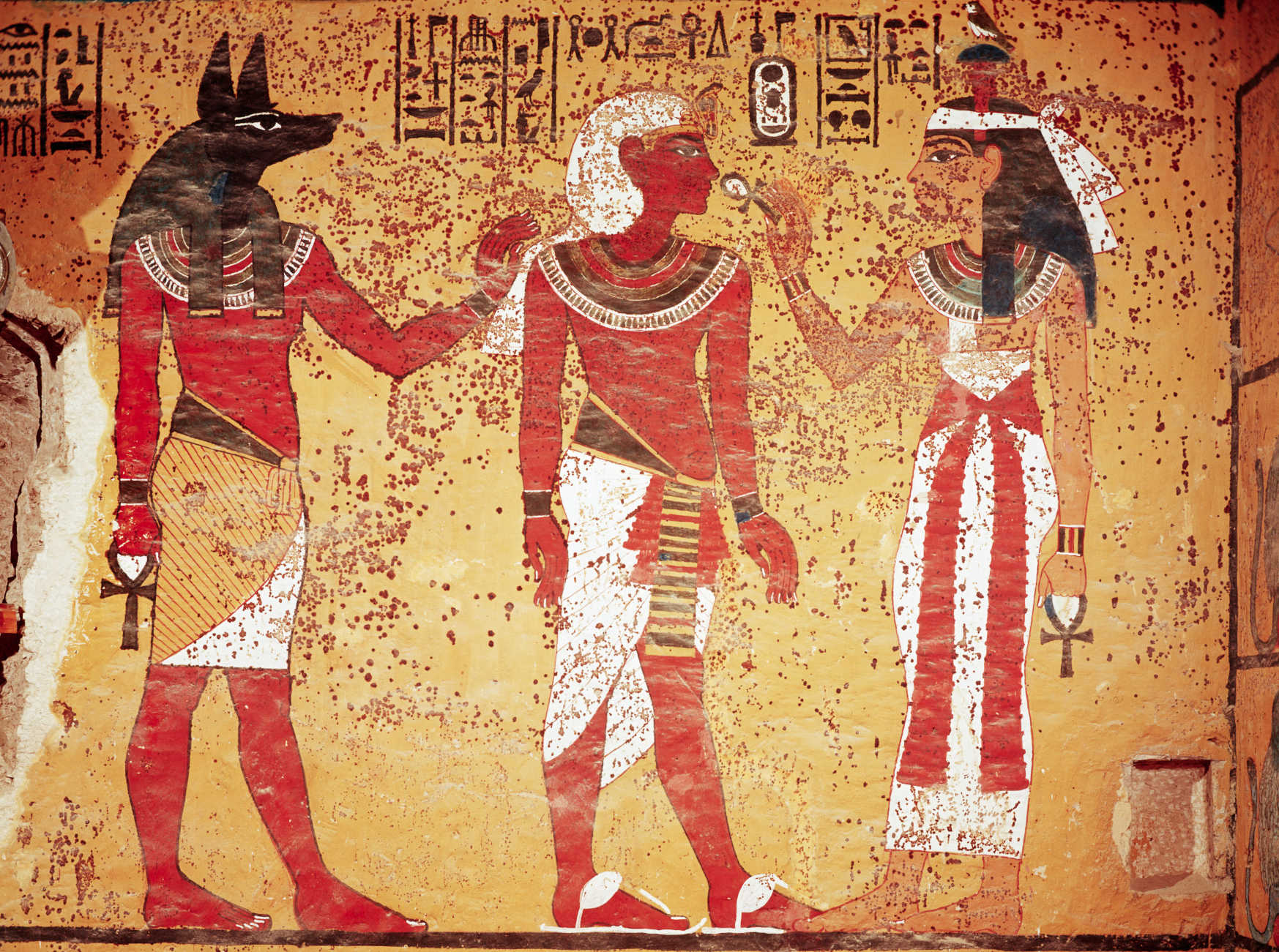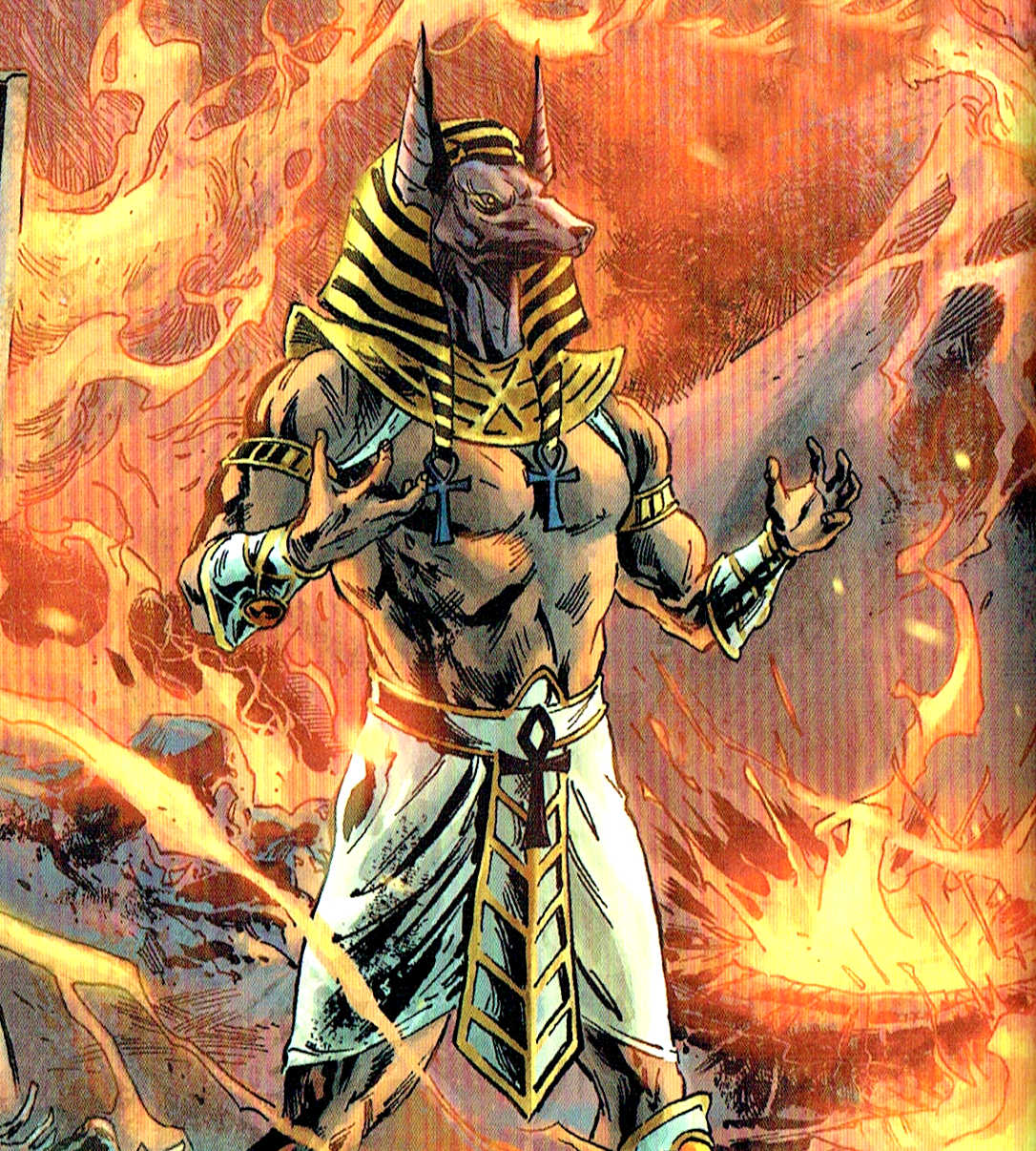
ANUBIS -
Is the protector of graves. Anubis was also an embalmer and lord of the underworld. One of his prominent roles was as a god who ushered souls into the afterlife. He attended the weighing scale during the "Weighing of the Heart", in which it was determined whether a soul would be allowed to enter the realm of the dead.
The sleeping mummy of Cleopatra is preserved almost intact,
while the god of tombs watches over her. Until, Safiya
Sabuka finds her mausoleum off the coast of Alexandria.
Anubis is a friend to Cleopatra,
in the context of the digital reincarnation of the Pharaoh
Queen. Looking over her tomb while submerged in the Mediterranean.
In the Ptolemaic period (350–30 BC), when Egypt became a Hellenistic kingdom ruled by Greek pharaohs, Anubis was merged with the Greek god Hermes, becoming Hermanubis. The two gods were considered similar because they both guided souls to the afterlife. The center of this cult was in uten-ha/Sa-ka/ Cynopolis, a place whose Greek name means "city of dogs." In Book XI of The Golden Ass by Apuleius, there is evidence that the worship of this god was continued in Rome through at least the 2nd century. Indeed, Hermanubis also appears in the alchemical and hermetical literature of the Middle Ages and the Renaissance.
Although the Greeks and Romans typically scorned Egyptian animal-headed gods as bizarre and primitive (Anubis was mockingly called "Barker" by the Greeks), Anubis was sometimes associated with Sirius in the heavens and Cerberus and Hades in the underworld. In his dialogues, Plato often has Socrates utter oaths "by the dog" (Greek: kai me ton kuna), "by the dog of Egypt", and "by the dog, the god of the Egyptians", both for emphasis and to appeal to Anubis as an arbiter of truth in the underworld.
EMBALMER
As jmy-wt (Imiut or the Imiut fetish) "He who is in the place of embalming", Anubis was associated with mummification. He was also called ḫnty zḥ-nṯr "He who presides over the god's booth", in which "booth" could refer either to the place where embalming was carried out or the pharaoh's burial chamber.
In the Osiris myth, Anubis helped Isis to embalm Osiris. Indeed, when the Osiris myth emerged, it was said that after Osiris had been killed by Set, Osiris's organs were given to Anubis as a gift. With this connection, Anubis became the patron god of embalmers; during the rites of mummification, illustrations from the Book of the Dead often show a wolf-mask-wearing priest supporting the upright mummy.
PROTECTOR OF TOMBS
Anubis was a protector of graves and cemeteries. Several epithets attached to his name in Egyptian texts and inscriptions referred to that role. Khenty-Amentiu, which means "foremost of the westerners" and was also the name of a different canine funerary god, alluded to his protecting function because the dead were usually buried on the west bank of the Nile. He took other names in connection with his funerary role, such as tpy-ḏw.f (Tepy-djuef) "He who is upon his mountain" (i.e. keeping guard over tombs from above) and nb-t3-ḏsr (Neb-ta-djeser) "Lord of the sacred land", which designates him as a god of the desert necropolis.
The Jumilhac papyrus recounts another tale where Anubis protected the body of Osiris from Set. Set attempted to attack the body of Osiris by transforming himself into a leopard. Anubis stopped and subdued Set, however, and he branded Set's skin with a hot iron rod. Anubis then flayed Set and wore his skin as a warning against evil-doers who would desecrate the tombs of the dead. Priests who attended to the dead wore leopard skin in order to commemorate Anubis' victory over Set. The legend of Anubis branding the hide of Set in leopard form was used to explain how the leopard got its spots.
Most ancient tombs had prayers to Anubis carved on them.
GUIDE OF SOULS
By the late pharaonic era (664–332 BC), Anubis was often depicted as guiding individuals across the threshold from the world of the living to the afterlife. Though a similar role was sometimes performed by the cow-headed Hathor, Anubis was more commonly chosen to fulfill that function. Greek writers from the Roman period of Egyptian history designated that role as that of "psychopomp", a Greek term meaning "guide of souls" that they used to refer to their own god Hermes, who also played that role in Greek religion. Funerary art from that period represents Anubis guiding either men or women dressed in Greek clothes into the presence of Osiris, who by then had long replaced Anubis as ruler of the underworld.
WEIGHER OF HEARTS
One of the roles of Anubis was as the "Guardian of the Scales." The critical scene depicting the weighing of the heart, in the Book of the Dead, shows Anubis performing a measurement that determined whether the person was worthy of entering the realm of the dead (the underworld, known as Duat). By weighing the heart of a deceased person against Ma'at (or "truth"), who was often represented as an ostrich feather, Anubis dictated the fate of souls. Souls heavier than a feather would be devoured by Ammit, and souls lighter than a feather would ascend to a heavenly existence.

IN ART
Anubis was one of the most frequently represented deities in ancient Egyptian art. He is depicted in royal tombs as early as the First Dynasty. The god is typically treating a king's corpse, providing sovereign to mummification rituals and funerals, or standing with fellow gods at the Weighing of the Heart of the Soul in the Hall of Two Truths. One of his most popular representations is of him, with the body of a man and the head of a jackal with pointed ears, standing or kneeling, holding a gold scale while a heart of the soul is being weighed against Ma'at's white truth feather.
In the early dynastic period, he was depicted in animal form, as a black canine. Anubis's distinctive black color did not represent the animal, rather it had several symbolic meanings. It represented "the discolouration of the corpse after its treatment with natron and the smearing of the wrappings with a resinous substance during mummification." Being the color of the fertile silt of the River Nile, to Egyptians, black also symbolized fertility and the possibility of rebirth in the afterlife. In the Middle Kingdom, Anubis was often portrayed as a man with the head of a jackal. An extremely rare depiction of him in fully human form was found in the tomb of Ramesses II in Abydos.
Anubis is often depicted wearing a ribbon and holding a (nḫ3ḫ3) "flail" in the crook of his arm. Another of Anubis's attributes was the jmy-wt or imiut fetish, named for his role in embalming.
In funerary contexts, Anubis is shown either attending to a deceased person's mummy or sitting atop a tomb protecting it. New Kingdom tomb-seals also depict Anubis sitting atop the nine bows that symbolize his domination over the enemies of Egypt.
WORSHIP
Although he does not appear in many myths, he was extremely popular with Egyptians and those of other cultures. The Greeks linked him to their god Hermes, the god who guided the dead to the afterlife. The pairing was later known as Hermanubis. Anubis was heavily worshipped because, despite modern beliefs, he gave the people hope. People marveled in the guarantee that their body would be respected at death, their soul would be protected and justly judged.
Anubis had male priests who sported wood masks with the god's likeness when performing rituals. His cult center was at Cynopolis in Upper Egypt but memorials were built everywhere and he was universally revered in every part of the nation.
In popular and media culture, Anubis is often falsely portrayed as the sinister god of the dead. He gained popularity during the 20th and 21st centuries through books, video games, and movies where artists would give him evil powers and a dangerous army. Despite his nefarious reputation, his image is still the most recognizable of the Egyptian gods and replicas of his statues and paintings remain popular.

OTHER NOTABLE DIETIES
Hatshepsut
Sobekneferu
(Neferusobek)
Nefertiti,
beautiful ancient Egyptian queen, architect of the sun cult
Cleopatra
last queen Egypt
Amina, queen for 34 years in Nigeria
Candace,
Ethiopian Empress, fearsome fighter who resisted Alexander the
Great
Semiramis,
female ruler Assyrian empire.
REFERENCE
https://www

CLEOPATRA
THE MUMMY - UNDER DEVELOPMENT
'Cleopatra
- The Mummy' is the sequel to 'Kulo-Luna.'
Kulo-Luna was
the first of the John Storm franchise (for which a draft
script is available to studios and actor's agents). The John Storm
franchise is a series of
ocean awareness adventures, featuring the incredible solar
powered trimaran: Elizabeth
Swann.